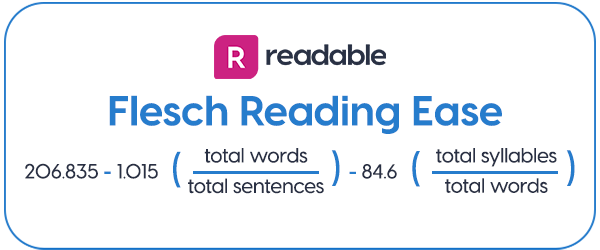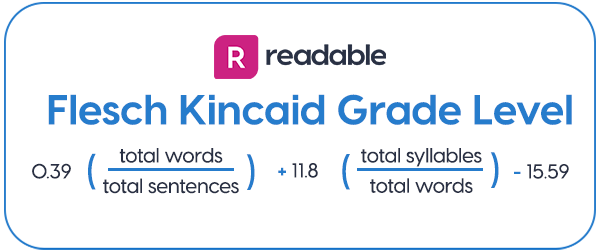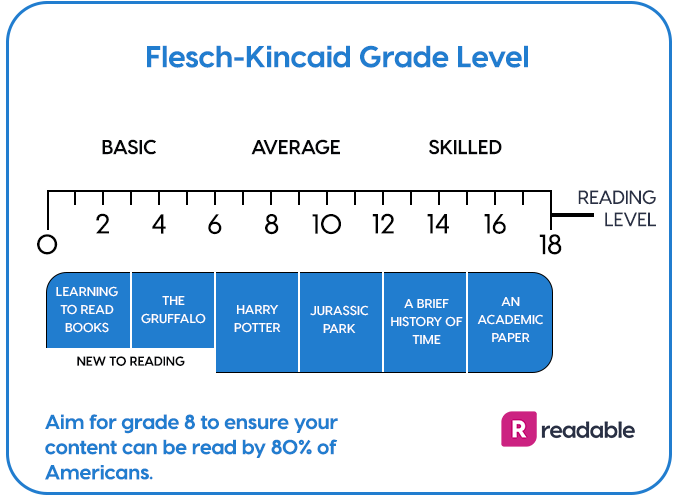What is the Flesch-Kincaid Grade Level?
The Flesch Kincaid Grade Level is the most widely used English readability formula. It assesses the approximate reading grade level of a text, based on average sentence length and word complexity. It produces scores corresponding to US grade levels, which are roughly equivalent to someone’s number of years of education.
Flesch-Kincaid Score | Reading Level | School Level | Age Range (US) | Example Book |
|---|---|---|---|---|
0 - 3 | Basic | Kindergarten / Elementary | 5 - 8 | Hooray for Fish! |
3 - 6 | Basic | Elementary | 8 - 11 | The Gruffalo |
6 - 9 | Average | Middle School | 11 - 14 | Harry Potter |
9 - 12 | Average | High School | 14 - 17 | Jurassic Park |
12 - 15 | Advanced | College | 17 - 20 | A Brief History of Time |
15 - 18 | Advanced | Post-grad | 20+ | Academic Papers |
The Flesch Reading Ease and Flesch-Kincaid Grade Level are both named for their creator, Rudolf Flesch, who developed these algorithms starting in the 1940s. When he first started his Reading Ease algorithm, he was working as a consultant with the Associated Press, developing methods for improving the readability of newspapers.
The first algorithm Flesch created was Flesch Reading Ease. This produced a score for the readability of text, usually between 0 and 100 (but not always), and the resulting score was difficult to make use of. An amended version, the Flesch-Kincaid Grade Level, was developed in the 1970s by Flesch and J. Peter Kincaid, together with the US Navy, with the intent to make the figure more accurate and easier to use. The Navy utilised it for their technical training manuals.
Today the Flesch-Kincaid Grade Level is used for a much wider variety of applications. If a text has a Flesch-Kincaid level of 8, this means the reader needs a grade 8 level of reading or above to understand it. Even if they’re an advanced reader, it means the content is less time-consuming to read.
What is a Flesch Reading Ease score?
The Flesch Reading Ease gives a text a score between 1 and 100, with 100 being the highest readability score. Scoring between 70 to 80 is equivalent to school grade level 8. This means text should be fairly easy for the average adult to read.
Now, over 70 years later, the Flesch Reading Ease is used by marketers, research communicators and policy writers, amongst many others. All use it to help them assess the ease by which a piece of text will be understood and engaged with.
How do Flesch tests work?
Flesch readability tests work by analysing sentence lengths and word complexity. The mathematical formulas underlying the two tests look like this:


At first glance, the formulas for the readability scores may not seem to make sense. But, the building bricks that make up both Flesch scores are straightforward and based on two factors:
- Sentence length. As judged by the average number of words in a sentence
- Word length. As judged by the average number of syllables in a word
Sentences that contain a lot of words are more difficult to follow than shorter sentences.
Many of the classics of English Literature were written in the 18th and 19th centuries. During this time, the average sentence was a lot longer than it is now.
You could have a long paragraph which was one long sentence; strings of clauses connected with peppered semicolons were the norm. However, because the average length of a sentence has decreased with time, so has our attention span. We no longer have the tolerance for lengthy, meandering prose.
Similarly, words that contain a lot of syllables are harder to read than words that use fewer syllables. For example, “it was a lackadaisical attempt” is more difficult to read than “it was a lazy attempt”.
What do the Flesch scores mean?
Both Flesch scores reflect how readable a piece of content is. The Flesch Reading Ease score is between 1 and 100, and the Flesch Kincaid Grade Level reflects the US education system. They are both calculated with the same units, but the weightings for these units are different between the two tests, resulting in different readability scores.
Flesch-Kincaid Reading Ease
The higher the reading score, the easier a piece of text is to read.
Note that this differs from the majority of readability scores where a lower score is easier.
For example, a reading score of 60 to 70 is equivalent to a grade level of 8-9 so a text with this score should be understood by 13 to 15-year-olds.
To make sense of a Reading Ease score, a conversion table is needed. This translates the score into a grade level.
Flesch-Kincaid Grade Level
The Flesch-Kincaid Grade Level is equivalent to the US grade level of education. It shows the required education to be able to understand a text.

Text intended for readership by the general public should aim for a grade level of around 8, schooling age 13 to 14.
When is Flesch-Kincaid most useful?
Flesch-Kincaid is ideal for:
- Writing copy for your website
- Advertising your product
- Producing terms and conditions that don’t confuse
- Boosting your SEO performance
- Choosing textbooks for a class or training program
- Editing your novel
- Communicating your research to a non-specialist audience
Readability scores can give you valuable insights into how easy your text is to understand. This has a direct impact on the extent people engage with and take on your message.
Content with a higher engagement rate has many benefits, including:
- Decreasing bounce rate
- Increasing time on site
- Content delivers for the reader
- Readers want to share your content
- Readers go further into your site
They also:
- Click on CTAs
- Add products to their shopping carts
- Spend money with you
- Keep on coming back
Having a readable website with engaging content is a boost for any business or organization.
How do the Flesch tests compare to other readability formulas?
Flesch scores are the most well-established in use cases ranging from marketing to government.
Whereas some formulas are more specialised, the Flesch-Kincaid Grade Level formula is currently the most widely used, and is appropriate for most writing.

